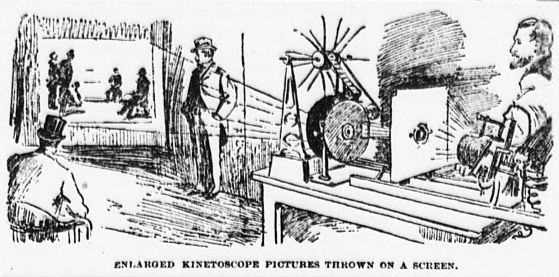Illustration accompanying New York Sun article on the debut of the Panoptikon
Source: ‘Magic Lantern Kinetoscope’, The Sun [New York], 22 April 1895, p. 2
Text: MAGIC LANTERN KINETOSCOPE
Edison Says Latham’s Device is Old and Promises to Beat It
An exhibition of what Edison considers a Kinetoscope so arranged as to throw pictures, enlarged, upon a screen was given yesterday afternoon at 35 Frankfort street by Woodville Latham. He calls his arrangement the Pantoptikon. The illustration gives a very good idea of what it looks like. The continuous film of photographic pictures with slots cut in the edges to catch the teeth of a sprocket that keep it from slipping is reeled in front of the electric light of a sort of magic lantern and so the pictures are thrown successively on the screen with sufficient rapidity to produce the well-known kinetoscope or zoetrope effect of animated pictures.
The pictures shown yesterday portrayed the antics of some boys at play in a park. They wrestled, jumped, fought and tumbled over one another. Near where the boys were romping a man sat reading a paper and smoking a pipe. Even the puffs of smoke could be plainly seen, as could also the man’s movements when he took a handkerchief from his pocket. The whole picture on the screen yesterday was about the size of a standard window sash but the size is a matter of expense and adjustment. Mr. Latham’s camera will take forty pictures a second and it can be set up anywhere in the street or on the top of a house.
Mr. Latham says that he will try to obtain a patent on his apparatus which thus enables the exhibitor to show kinetoscope effects to a large audience at one time.
A Sun reporter saw Mr Edison last evening and described the Latham machine to him. Hearing the description, Mr. Edison said:
“That is the kinetoscope. This strip of film with the pictures, which you have here, is made exactly as the film I use. The holes in it are for the spokes of the sprocket, which I devised.
“The throwing of the pictures on a screen was the very first thing I did with the kinetoscope. I didn’t think much of that, because the pictures were crude and there seemed to me to be no commercial value in that feature of the machine.
“In two or three months, however, we will have the kinetophone perfected, and then we will show you screen pictures. The figures will be life size and the sound of the voice can be heard as the movements of the figures are seen.
“If Mr Latham can produce life-size pictures now as we will do with the kinetophone that’s a different matter.
“When Latham says he can set up his kinetograph anywhere and take the pictures for his machine, he means that he has simply a portable kinetograph.
“We have had one of those for six months. The reasons that our pictures all had to be taken here at first was that our kinetograph was unwieldy.
“If they exhibit this machine, improve on what I have done, and call it a kinetoscope, that’s all right. I will be glad of whatever improvements Mr. Latham may make.
“If they carry the machine around the country, calling it by some other name, that’s a fraud, and I shall prosecute whoever does it. I’ve applied for patents long ago.”
Comments: Major Woodville Latham and his sons Grey and Otway exhibited the first public demonstration of motion pictures projected on a screen in the United States on 21 April 1895. Their machine, billed as the Panoptikon, took place at their company offices at 35 Frankfort Street, New York. The film they exhibited had been taken on the roof of the shop (not in a park as this account states), with Woodville Latham portraying the man with a newspaper and pipe. Thomas Edison’s chief engineer on his own motion picture work with the Kinetoscope peepshow, William Kennedy-Laurie Dickson, had been secretly aiding the Lathams. Edison was only able achieve film projection on 23 April 1896, with his Vitascope projector (devised by Thomas Armat and Charles Jenkins). The Lathams began commercial exhibition of what was renamed the Eidoloscope on 20 May 1895, but the projection quality was poor and it was not a success.
Links: Copy at Chronicling America
